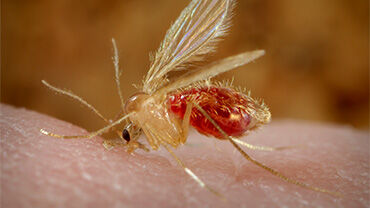The spatial relationship between the presence and absence of Leishmania spp. and leishmaniasis, and phlebotomine sand fly vectors in Europe and neighbouring countries
This report provides an analysis of the spatial relationship between the presence and absence of autochthonous Leishmania spp. and clinical cases in humans and animals, and the presence and absence of their confirmed and suspected respective Phlebotomus spp. vectors, in Europe and neighbouring countries.
Executive summary
Objectives
To provide an analysis of the spatial relationship between the presence and absence of autochthonous Leishmania spp. (L. infantum, L. tropica, L. major and L. donovani sensu stricto) and clinical cases in humans and animals, and the presence and absence of their confirmed and suspected respective Phlebotomus spp. vectors, in Europe and neighbouring countries.
Methods
The geographical location of Leishmania spp. infections and clinical cases at ECDC territorial polygon resolution (equivalent to NUTS-3 and GAUL-2 in most countries) was obtained from a review of the scientific literature published between January 2009 and July 2020 [1], and vector distribution data came from the February 2021 ECDC-VectorNet database update. The review excluded leishmaniasis cases explicitly described as imported (from another country or region). However, as the place of infection could not be established in most instances, it is possible that some areas without autochthonous transmission may have been classified as having presence of leishmaniasis. The geographical area analysed was defined by the combined area of leishmaniasis and vector distribution areas, which were estimated by joining the centroids of the outermost consecutive ECDC territorial polygons where they were reported as present, using a geographical information system. The frequencies of polygons where leishmaniasis and vectors were present were calculated and the agreement between distributions was assessed using Cohen’s kappa coefficient and logistic regression, not accounting for spatial auto-correlations.
Results
Most of the parasite and vector spatial relationships tested were statistically significant (p<0.05), although Cohen’s kappa indicated slight agreement for L. donovani s.s., L. tropica and L. major spatial distributions and the distributions of their respective vectors, and fair agreement for L. infantum distribution and its 11 confirmed and suspected Phlebotomus spp. In regression analysis, McFaddens adjusted pseudo-R-squared statistic indicated that the spatial distributions of P. perniciosus, P. tobbi, P. alexandri and P. kandelakii significantly explained 9.4% of the observed variation in the combined L. infantum and visceral leishmaniasis distribution, with P. perniciosus and P. tobbi accounting for 75% and 22% of this, respectively. For L. donovani s.s., P. major s.l. and P. halepensis explained 25% of the observed variation with P. major s.l. accounting for 69%. For L. tropica, P. sergenti explained 5.5% of the variation, and for L. major, P. papatasi explained 9.8%.
Discussion
The analysis showed that the distributions of a small number of vector species out of all confirmed and suspected vectors could explain some of the variation in the spatial distribution of Leishmania species and clinical forms. This result may be considered (weak) epidemiological evidence of differences in vectorial capacity among vector species that should be further investigated.
The overall low degree of agreement between parasite and vector distributions can be attributed to (i) Leishmania vectors being reported beyond the geographical limits of autochthonous Leishmania spp. infections; (ii) scarce and spatially heterogeneous vector distribution information, (iii) Leishmania species and clinical forms being frequently underreported, and (iv) the administrative units used in the study not necessarily reflecting sandfly and Leishmania ecology and possibly being unbalanced.
This study highlights a number of areas where Leishmania species and/or clinical forms have been diagnosed but no vectors have been reported so far, supporting the need for enhanced vector surveillance. Considering enhanced Leishmania spp. surveillance in periendemic areas where vectors are present may facilitate detection of parasite introduction via movement of infected people and animals.







